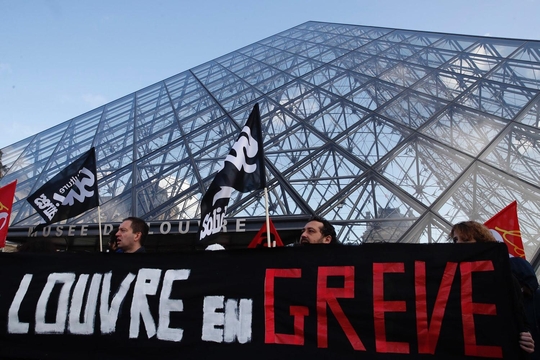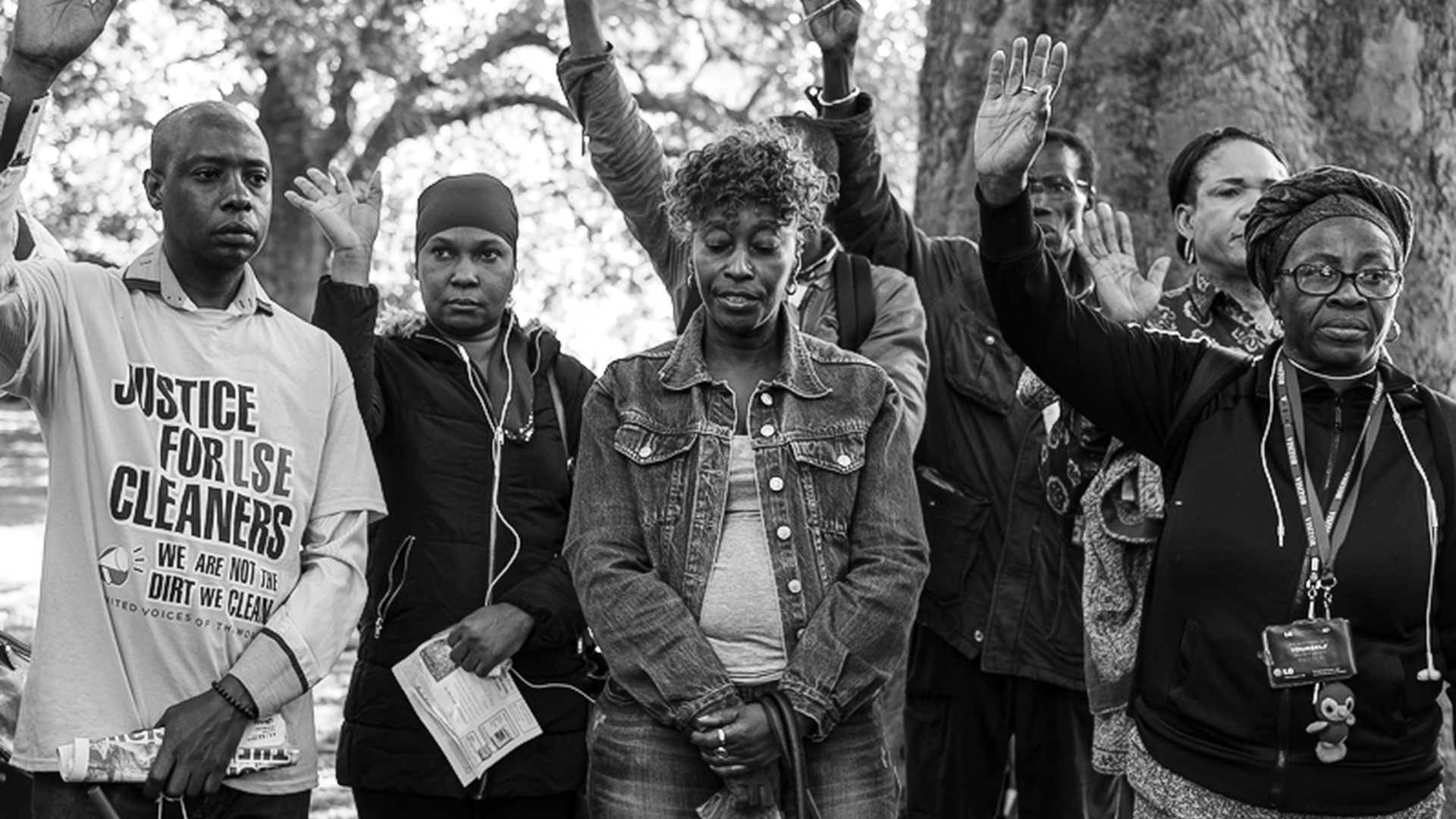Mere Shells: Fighting Outsourcing in France’s Museums
by
Valentin J.,
Ethel L.
August 22, 2025
Featured in Dispassions: Class Struggle in Arts & Culture (#24)
The prospects and challenges of organising in France’s increasingly hollow cultural institutions

inquiry
Mere Shells: Fighting Outsourcing in France’s Museums
The prospects and challenges of organising in France’s increasingly hollow cultural institutions
In Paris, you might enter museums and art institutions, purchase your tickets, go through a security check, and leave your stuff in a cloakroom. All the workers there are wearing the same uniform, along with a badge bearing the logo of the Louvre or the Louis Vuitton art foundation. Yet, you might not have noticed that nearly all of the workers you went by are not working for these museums despite being the “face” of the institutions: they work for a subcontractor/external service provider, with the museum relying on outsourcing for nearly everything but the exhibition itself.
Muséa, Pénélope, Marianne International, City One: for the last twenty years these companies have seen their remit grow inside museums. They are service providers and sell reception and guided tour services to museums. This trend began in the mid-2000s, starting with the Quai Branly Museum, and became widespread in the 2010s across both national museums and private institutions, with nearly every service - from security and cleaning to reception, building maintenance, and guided tours - now outsourced.
The introduction of private actors and the shift in museum priorities toward public engagement have led to a division of labour across tasks that were once performed by a unified body of civil servants responsible for reception and invigilation. These new service providers have reshaped front of house roles such as reception, invigilation, and guided tours - roles that involve direct interaction with the public. It is widely understood that outsourcing promotes the specialisation of work, fragmenting previously integrated duties. This division of labour is also marked by a homogenisation of social profiles assigned to each specialised role. In the cases examined here, for example, women are predominantly employed in public engagement and reception roles, while men are concentrated in invigilation positions. Concurrently, sociological studies show that outsourcing not only reinforces but also reproduces gender norms, rendering certain forms of labour invisible and ‘naturalising’ gender divisions across remits such as conservation, knowledge transmission, and visitor interaction.1
How did the organisation of work in museums become so divided? Let’s explore some possible reasons. First, France’s policies have increasingly focused on tightening the state budget. Culture and cultural institutions have been heavily reliant on public subsidies since the 20th century. This reliance evolved into a formal state commitment to providing public cultural services with the establishment of the Ministry of Culture in 1959. Although the Ministry was founded with the goal of making art accessible to everyone, sociological studies in the late 1960s revealed that museums remained spaces primarily frequented by those who felt ‘entitled’ to visit and engage with art.2
Alongside a growing sense of ‘disenchantment’ with the idea of the universal experience of art promoted by institutions, the 1980s saw a change in policy culture and ethos. Rationalisation, budget cuts and inspiration drawn from the private sector became the driving forces for successive governments, intensifying over the years. An academic name has been given to this ethos : NPM, New Public Management.
Another dynamic can be observed: museums follow a ‘star system’ model, where a small number of institutions account for 90% of national visitor numbers, while the remaining museums collectively attract only about 10%. Since the 1990s, major public museums - beginning with the Louvre - have gradually gained autonomy from the Ministry of Culture. This shift allows them to retain the profits they make and manage their own budget instead of redistributing part of it to smaller institutions, as was previously the case. As a result they can independently decide how to allocate their funds, whether toward hiring, investments, or other priorities.
While this decision might have seemed right at the time, it also pressured some museums to limit deficits or even generate profits, a rather difficult task in the cultural sector. Moreover, a change in the policy regulating the hiring of public servants’ in 2008 limited the number of workers employed directly by the state, which also impacted public museums.3 Institutions are encouraged - or even pressured - to make ends meet with fewer workers and stagnant subsidies all while facing ever growing visitor numbers. Overall, over the past 30 years, both public and private cultural institutions have increasingly adopted managerial concepts from the industrial sector, such as “just-in-time” workforces, which allows them to adapt to visitor peaks and seasonal fluctuations, hence creating short-term contracts.
The phenomena described above might be the factors that encouraged museums to engage service providers for tasks enabling public access. Several explanations have been given for this tendency, the main one being that museums tend to focus on their core business: the production of exhibitions.4 However, a more pragmatic explanation may be the actual driver: it allows the institutions to always have a full complement of staff and adapt to fluctuating seasonal demand without the burdens of direct staff management. Service providers, acting as co-contractors, offer far more flexibility than individual workers and assume responsibility for human resources. Contracts between museums and service providers typically specify only the number of ‘positions’ required, depending on seasonal visitor fluctuations. Providers are then free to recruit as they see fit in order to ensure profitability, while loosely aligning with the museums’ preferences. This often results in a small number of permanent staff supported by a rotating pool of short-term contract workers, though variations exist. In the case of guided tours, subcontractors sometimes serve merely as intermediaries between museums and freelance guides. Conversely, in some museums, outsourced reception staff are almost entirely permanent employees. The inconsistency of employment practices across institutions reduces opportunities for shared interests and solidarity among museum workforces.
It is already politically questionable for national museums to rely so heavily on outsourcing as this effectively ties their survival to private companies. But unsurprisingly such a system also bears serious problems for working conditions, management and pay. Workers for these service providers have much worse terms and conditions than internal museum workers. Day-to-day, the different labour agreements under which they operate result in outsourced reception staff experiencing frequent shift changes, later night-time working hours and significantly inferior hourly rates… We must add that these labour agreements have not been thoroughly updated for 20 years!
The working conditions for outsourced museum staff are worsened by a twofold surveillance: they are often monitored by a manager from the service provider as well as closely watched by administrative museum staff ensuring they fulfill the terms of the contract. Legally, outsourced workers cannot take orders from the museums. So information and work adjustments must go from the museum to the service provider, who then instructs their managers who will brief the reception staff, invigilators or guides.
Outsourcing also affects how workers perceive their own roles. In our case, the reception staff we interviewed expressed a strong sense of detachment from the institutions they work in. Some also reported feeling disconnected from art and culture, despite working in museums. This is partly because contracts between museums and service providers sometimes prohibit them from engaging with visitors on those subjects - even when stationed directly in front of artworks or collections. While such experiences may vary across different roles, for reception staff, this disconnection can contribute to a devaluation of their work, compounded by the sense of performing invisible tasks such as greeting visitors and providing information.
Outside of these structural problems, some of these providers rely on severe management. In response, workers sometimes threaten complaints to the Inspection du travail (IT)5, but this often leads to the non-renewal of their contracts. Most of the time, however, complaints to the IT prove futile, as they depend on the worker remaining employed by the company until an inspection takes place - a process that can take up to a year, despite high staff turnover. Human resources management poses an additional challenge. While we do not want to defend the existence of human resources, severe understaffing at upper management levels forces workers to personally verify their pay against their working hours. In another case, a simple request for a proper break room has taken months and remains unresolved, with the outsourcing company and the museum blaming each other for the inaction.
To be honest, we were not the first ones challenging these issues. There had been efforts to challenge these practices occurring for years. The situation in French museums is indeed dire, with under-staffing and buildings suffering serious structural issues. But most of the strikes and protests were carried out by directly employed workers, far more unionized and with more stable jobs than us. With a lot of our colleagues signing short contracts (sometimes a day long!), it’s understandable that they would be reluctant to engage in this kind of struggle, especially when an official strike means losing a considerable part of their monthly wage while facing severe insecurity. A strike would have little effect anyway: some of our coworkers have a volant, or ‘flying’ contracts, meaning they can be assigned to almost any workplace where our employer needs them. With outsourced workers being easily replaceable, a strike in one workplace would have very little impact. Outsourcing service providers have a pool of workers available if a person is absent. In the case of a strike, some people contacted by the company to fill shifts might not even know that they are strikebreakers until they arrive on site.
As such, how could we, workers in museums, not even working for the museum, find ways to fight against this, to regain our agency when we rarely, if ever, encounter our colleagues from the same service provider working at other sites across Paris? How could we organise collective resistance when everyone feels they have too much to lose to take action? Answering these questions is particularly difficult given that the different service providers rarely communicate beyond strictly day-to-day operational matters, which limits the possibility of uniting struggles across different companies. In the end, several of our comrades organized, with the help of Sud, Union syndicale solidaires. These workers, mostly from the Palais de la Porte Dorée, were fed up with the vague and ever-expanding scope of their duties. The museum frequently asked them to take on tasks such as invigilation, gardening, and cleaning, none of which fell under their official job descriptions. Furthermore, the opening of the new Museum of the History of Immigration in the same building brought an influx of visitors, adding further strain to staff, yet the additional workload remained unacknowledged. What set these colleagues apart was their prior involvement in trade union activism - some were even union members, which is relatively uncommon in France, where union membership remains particularly low. These colleagues already knew who to reach out to, were more determined, and had a better understanding of their rights than others. With the help of lawyers and comrades, our union filed a legal complaint against four museums and three outsourcing firms: the Louvre (working with Muséa), the Marseille museum Mucem (with Pénélope) and the Bourse de Commerce and the Palais de la Porte Dorée (with Marianne International).
The legal file was not targeted directly at our working conditions, something that, as we wrote, is the remit of the Labour Inspection. It was filed against the practice of outsourcing itself, the supposed offenses being “prêt de main d’oeuvre illicite” and “délit de marchandage”, two offenses that may be tried by the judicial court. First, the “prêt de main d’oeuvre” refers to the illegal use of an outside workforce. With this, we are making the case that the work we do in museums is central to their core mission and therefore should not be outsourced to external providers. Secondly, the “marchandage” challenges the unfairness of outsourcing, as it denies us the rights and benefits that in-house employees receive.
Along with this complaint, several newspapers began covering the issue of outsourcing in Museums, most notably the left-leaning Libération, which showed early interest. In the end, to our own surprise, the story received widespread coverage - from local TV and national radio to Québécois newspapers - largely because the Louvre was involved.
While the press had given some coverage to the hardship of workers on several outsourced sites over the years, the subject finally came fully into the light. For our comrades, the overwhelming feedback from the campaign was a sense that their struggles were finally acknowledged, that they were seen - and that they weren’t alone. What we can say for sure is that the campaign has made a mark and that many of our comrades have come to really understand how working for an external service provider worsens our working conditions. As for the legal complaint, while we cannot completely rely on it, we still hope that it establishes precedent. However, while the prospect of ending our own outsourcing, and reintegrating museums is not impossible (such cases have happened in the past, mostly in telecommunications), it is still unlikely. But if such an opportunity were to arise, we would gladly seize it. Many of us are, in fact, more or less satisfied with our work - we only hope for more staff, better wages, and greater recognition, as most workers probably do.
But what we mostly wanted was to shine a light on outsourcing in the culture sector. As we wrote earlier, one can enter and move through a whole museum without interacting with a single museum employee. Reception, guides, even security or cleaning, should not be thought of in terms of profit in the case of museums. As we sometimes say to people asking us about this whole mess: museums end up turning into businesses with no workers, only managers. What is the limit to outsourcing in museums, when legislation allows museums to use more and more service providers for their activities? What impact will it have on access to art, to have a divided and outsourced workforce in cultural institutions, from the people welcoming visitors to the ones presenting and explaining artworks? And will museums lose their ability to run a functional place if all of their skills are progressively entrusted to outside parties?
For now, the use of outsourcing has been explained officially (and ironically) by museum managers wanting to focus on their “core missions” : making exhibitions. But now, with national museums renting out spaces for private exhibitions, and relying more than ever on private events for revenue, one has to wonder: will they go even further and outsource the exhibition-making process itself?6 Our fear is that museums will become mere shells - heartless institutions solely focused on self-preservation, effectively disappearing in spirit.
-
Schütz, G. (2022). Subcontracting Through a Gender Lens: An Analysis of the “permanent” Outsourcing of General Services Based on the Case of Reception Services. Entreprises et histoire, No 107(2), 45-59. https://doi.org/10.3917/eh.107.0045. ↩
-
See Bourdieu, P., & Darbel, A. (1969). L’amour de l’art : Les musées d’art européens et leur public. In Les Éditions de Minuit ↩
-
The 2008 is called RGPP, révision générale des politiques publiques (General Public Policy Revision), and mainly allows only one out of two public servants retiring to be replaced. ↩
-
See the ‘ethics’ debate organised by the French National Committee of ICOM (International Council of Museums) on March 24th 2025 : https://www.icom-musees.fr/ressources/pour-une-delegation-responsable-musees-et-externalisation ↩
-
Labour inspection ↩
-
An interesting case is “Machu Picchu and the treasures of Peru” at the Cité de l’Architecture et du Patrimoine ; the entire temporary exhibition wing was lended to private contractor World Heritage Exhibitions LLC. See: https://www.citedelarchitecture.fr/fr/exposition/machu-picchu-et-les-tresors-du-perou ↩
Subscribe to Notes from Below
Subscribe now to Notes from Below, and get our print issues sent to your front door three times a year. For every subscriber, we’re also able to print a load of free copies to hand out in workplaces, neighbourhoods, prisons and picket lines. Can you subscribe now and support us in spreading Marxist ideas in the workplace?
Read next

Rebellion at the LSE: a cleaning sector inquiry
by
Achille Marotta,
Lydia
/
Feb. 9, 2018

